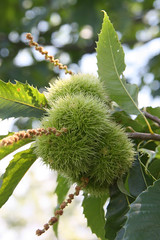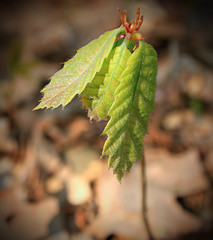 American chestnut (Castanea dentata) was once a common canopy tree in the eastern U.S.
American chestnut (Castanea dentata) was once a common canopy tree in the eastern U.S.
Photographers: Flickr users Erin & Lance Willett
"Chestnuts roasting by an open fire..." Historically, American chestnut played an important part in the story of hillside forests in eastern North America. Once the dominant tree in these forests—often comprising 35 percent to 50 percent and sometimes more of the canopy throughout the Mid-Atlantic region1 2—the fast-growing American chestnut provided untold ecological services. Its foliage, fruits, and living wood supplied food for all kinds of wildlife, from bears and turkeys to native insects. It easily survived wildfires and outbreaks of native insects and diseases. Its dependable, abundant crops of chestnuts were important not only for wildlife, but in the diets of Native Americans, and later, European immigrants who incorporated them into daily life as well as Christmas traditions. Its durable, high quality wood was widely used in construction and carpentry. But since the 1930s, American chestnut has all but disappeared. Store-bought chestnuts today come from European stock or hybridized strains. What happened?
In the early 1900s, chestnut blight, a fungal pathogen accidentally brought to the U.S., started appearing on American chestnut trees. Within a matter of just three or four decades, the fungus—and the removal of healthy trees to try to stop its spread—wiped out essentially every mature American chestnut tree. After the loss of American chestnut, drought-tolerant oaks appear to have increased where American chestnuts once grew.3 4 Some of the hillside forests you see today at Rock Creek Park look vastly different than they did when the park was established in 1890!
 Spindly American chestnut sprouts have leaves with long teeth on their margins.
Spindly American chestnut sprouts have leaves with long teeth on their margins.
Photographer: Flickr user Nicholas A. Tonelli
You can still find American chestnut sprouts here and there in forests at Rock Creek Park. Unfortunately, before most stems get big enough to produce fruit, the chestnut blight fungus finds its way into a crack in the bark and kills it back. Though the sprout dies, the root lives on, and continues to send up new sprouts from buds at the base of the old stem. So the sprout you see today probably comes from a seed that first sprouted a century ago or more, and it may continue to regenerate sprouts for decades or centuries to come!
Keep an eye out for American chestnut sprouts in the woods. Look for often only a pencil-thick, spindly sapling (little to no branching), sometimes waist high or more. The leaves are similar to the chestnut oak, but with very sharply pointed teeth.
- 1. . 1910. The ecological plant geography of Maryland; coastal zone; eastern shore district.
- 2. . 1974. Plant communities on a quartzite ridge in Chester County, Pennsylvania. Proceedings of the Pennsylvania Academy of Science . 48:101-106
- 3. . 1973. Distribution of major forest species in southeastern Pennsylvania. Ecological Monographs. 43:303-327
- 4. . 1978. A study of forest communities in southern Chester County, Pennsylvania. Proceedings of the Pennsylvania Academy of Science 52:37-44.


